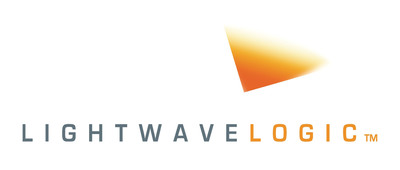Energy savings drive Photonic IC roadmap to polymers
22 October 2019
ENGLEWOOD, Colo., Oct. 22, 2019 /PRNewswire/ -- Lightwave Logic, Inc. (OTCQB: LWLG) is pleased to report that energy-saving polymer technology is highlighted in the recently published Integrated Photonics Systems Roadmap – International (IPSR-I). This important industry roadmap was defined jointly by a global network of Industrial and R&D partners. The roadmap model is based on the highly successful roadmap that has enabled the CMOS industry to navigate Moore's Law for decades.

Under pressure to produce improvements in Cost, Size, Weight and Power consumption (CSWaP) simultaneously, the photonics industry is using the roadmap to define how multiple technology and systems requirements can be coordinated to enable faster developments. These improvements are required to control the total cost of ownership for fundamental datacenter and sensor infrastructure that is under stress by rapid growth of data, compute and sensing.
"This roadmap highlights exactly the applications that we are tackling, as well as the challenges we and our counterparts around the world are facing," said Michael Lebby, CEO of Lightwave Logic. "Our differentiation lies in the use of polymers for high-speed active devices." Polymers are on the roadmap for both passive interconnect and active devices due to unique benefits they bring to meet the current and future challenges.
The roadmap is needed to create a common platform that spans today's most urgent need for high-volume low-mix datacom transceivers to the rapidly emerging high-mix market of Industrial Internet of Things ((I)IoT) sensors. Unlike for CMOS, the challenge is to span a wide variety of photonic technologies which each contribute specific functions. For many applications, increasing the speed of devices provides reduced cost, size and weight—but tends to increase power consumption. Hyperscale datacenters are constrained in growth by their power consumption.
"The big problem across multiple applications is that as device speeds go up, the power consumption skyrockets. If you look at the called-out requirements for datacom and, in a completely different section of the roadmap document, the requirements for RF applications, they are both asking for a roadmap to 100 GHz at low voltages that can come directly from CMOS," said Lebby. "That commonality is where you see the incredible power of an industry roadmap."
Lightwave Logic is aiming squarely at the 100 GHz, direct-drive target with a proprietary material with high electro-optic activity, meaning it can operate with very low voltage: a truly green low energy solution. Earlier this year, the company had announced a breakthrough that doubled the electro-optic activity of its material. This highly stable active polymer material enables extremely high-speed and low power optical modulators that convert data from electric signals into optical signals for transmission over optical fiber or free space.
For a copy of the roadmap summary, or more information about Lightwave Logic, please visit the Company's website at lightwavelogic.com.
Powered by Lightwave Logic
Lightwave Logic, Inc. is a development stage company moving toward commercialization of next generation photonic devices using its high-activity and high-stability organic polymers for applications in data communications and telecommunications markets. Photonic electro-optical devices convert data from electric signals into optical signals.
Safe Harbor Statement
The information posted in this release may contain forward-looking statements within the meaning of the Private Securities Litigation Reform Act of 1995. You can identify these statements by use of the words "may," "will," "should," "plans," "explores," "expects," "anticipates," "continue," "estimate," "project," "intend," and similar expressions. Forward-looking statements involve risks and uncertainties that could cause actual results to differ materially from those projected or anticipated. These risks and uncertainties include, but are not limited to, lack of available funding; general economic and business conditions; competition from third parties; intellectual property rights of third parties; regulatory constraints; changes in technology and methods of marketing; delays in completing various engineering and manufacturing programs; changes in customer order patterns; changes in product mix; success in technological advances and delivering technological innovations; shortages in components; production delays due to performance quality issues with outsourced components; those events and factors described by us in Item 1.A "Risk Factors" in our most recent Form 10-K; other risks to which our Company is subject; other factors beyond the Company's control.
Contact:
Karen Liu
Lightwave Logic, Inc.
karen@lightwavelogic.com
+1 720 356 4497
![]() View original content to download multimedia:http://www.prnewswire.com/news-releases/energy-savings-drive-photonic-ic-roadmap-to-polymers-300943135.html
View original content to download multimedia:http://www.prnewswire.com/news-releases/energy-savings-drive-photonic-ic-roadmap-to-polymers-300943135.html
SOURCE Lightwave Logic, Inc.

